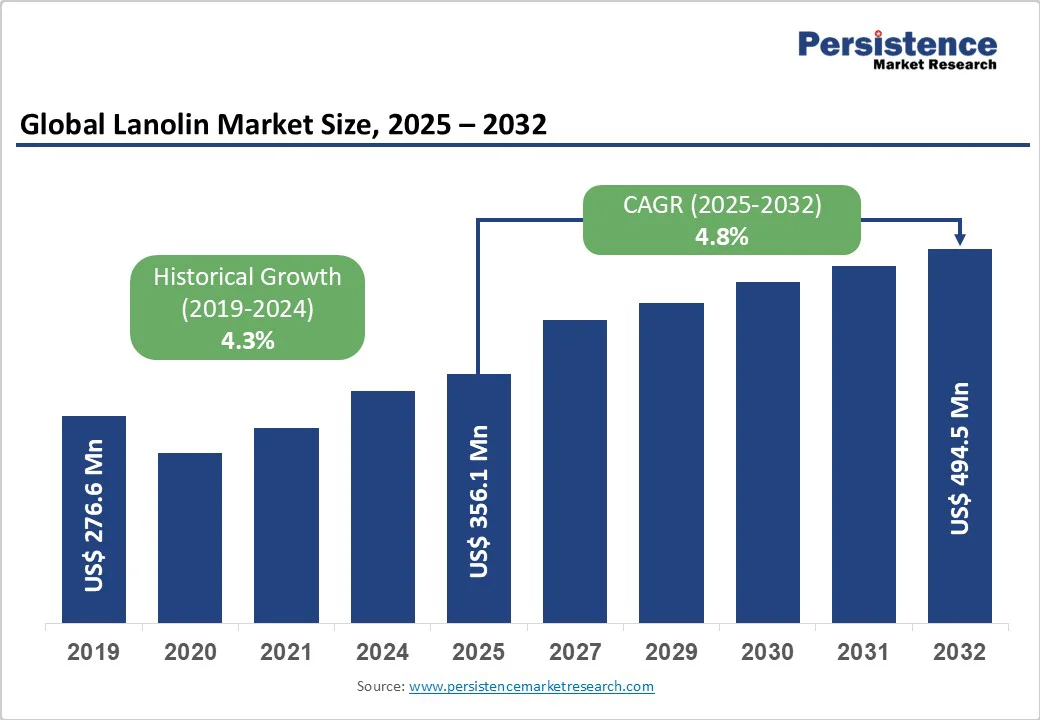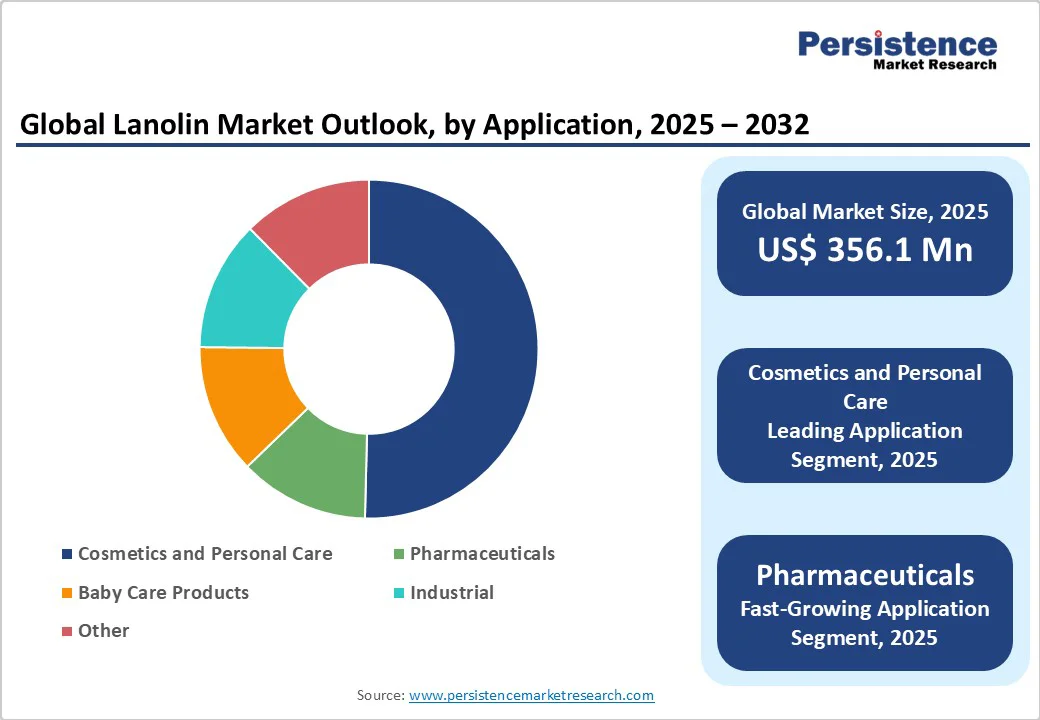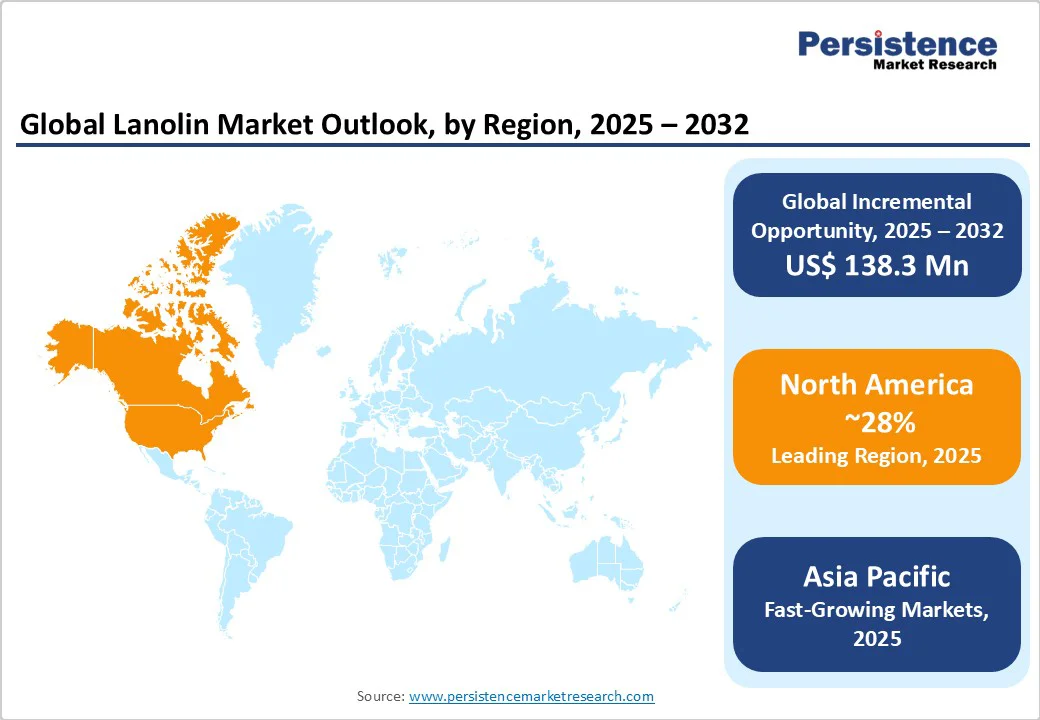ID: PMRREP13168| 200 Pages | 27 Oct 2025 | Format: PDF, Excel, PPT* | Chemicals and Materials

The global lanolin market size was valued at US$356.1 Million in 2025 and is projected to reach US$494.5 Million by 2032, growing at a CAGR of 4.8% during the forecast period from 2025 to 2032, driven by rising consumer preference for natural ingredients in personal care and pharmaceutical products, along with growing awareness of sustainable and hypoallergenic formulations. This growth is also driven by the product's emollient properties, which enhance skincare formulations, as evidenced by the surge in organic cosmetics adoption globally, where natural waxes such as lanolin are preferred over synthetics.
| Key Insights | Details |
|---|---|
|
Lanolin Market Size (2025E) |
US$356.1 Mn |
|
Market Value Forecast (2032F) |
US$494.5 Mn |
|
Projected Growth CAGR (2025-2032) |
4.8% |
|
Historical Market Growth (2019-2024) |
4.3% |

The primary driver for the market is the escalating preference for natural and organic ingredients in cosmetics and personal care products, which aligns with global clean beauty trends. Consumers are increasingly seeking hypoallergenic and sustainable alternatives to synthetic emollients, with lanolin's wool-derived moisturizing properties making it ideal for lotions, lip balms, and creams.
According to industry reports, the shift toward eco-friendly formulations has led to a 30% increase in natural wax usage in skincare over the past five years, as highlighted by the Cosmetic Ingredients Market's emphasis on biodegradable components. This trend is supported by certifications from organizations such as Ecocert, which validate lanolin's natural status, thereby enhancing its appeal in premium product lines and driving market penetration. Pharmaceutical endorsements further amplify this, as lanolin's non-comedogenic nature reduces skin irritation risks, fostering trust among formulators and end-users.
Lanolin's therapeutic emollient qualities are fueling its growth in the pharmaceutical sector, particularly for dermatological treatments and wound healing ointments. Its ability to form a protective barrier on the skin accelerates recovery, as demonstrated in clinical studies showing 20-25% faster healing rates in lanolin-based creams compared to petroleum alternatives.
Regulatory bodies such as the FDA and EMA have approved lanolin for topical use due to its biocompatibility, encouraging its integration into over-the-counter medications. This is evidenced by the rising production of medicated balms, where lanolin constitutes up to 15% of formulations in leading brands, supported by data from the personal care chemicals ingredients market indicating sustained demand for multifunctional actives. As aging populations worldwide seek gentle, effective remedies, this application is projected to contribute significantly to overall market expansion.
A key restraint in the market is the occurrence of allergic reactions, particularly among individuals sensitive to wool proteins, which can limit its adoption in sensitive skincare. Studies from dermatological associations report that 1-2% of users experience contact dermatitis, prompting some manufacturers to seek alternatives despite lanolin's benefits. This issue is compounded by stringent labeling requirements under regulations such as the EU Cosmetics Regulation, which mandate allergen disclosure, potentially deterring hypoallergenic product developers.
As consumer awareness grows via platforms such as the American Academy of Dermatology, brands face challenges in marketing lanolin-inclusive products, leading to slower growth in allergy-prone demographics.
Fluctuations in wool production pose a significant barrier to the lanolin market, as the product is derived from sheep's wool grease, making supply dependent on agricultural factors such as weather and livestock health. Global wool output variability, with a 10-15% annual fluctuation reported by the International Wool Textile Organisation, increases raw material costs and disrupts consistent availability.
Ethical concerns over animal welfare in sourcing, highlighted by campaigns from groups such as PETA, add regulatory scrutiny, especially in regions enforcing sustainable farming standards. These factors elevate production expenses, squeezing margins for manufacturers and hindering scalability in price-sensitive markets.
Market participants can capitalize on opportunities in developing refined lanolin derivatives that minimize allergens, targeting the growing clean beauty segment expected to surge with the Baby Care Product Market's focus on gentle ingredients. Recent advancements in purification technologies have reduced pesticide residues by 90%, as per innovations from chemical engineering journals, enabling hypoallergenic variants for sensitive skin applications.
With the global push for organic certifications, companies investing in these derivatives could capture a 25% share of the premium cosmetics niche, supported by developments such as pharmaceutical-grade ethoxylated lanolin for eczema treatments. Policy incentives under the EU Green Deal for sustainable innovations further enhance potential, with projections indicating a 6-7% CAGR in derivative sales through 2032.
Opportunities abound in extending lanolin's use to novel pharmaceutical and industrial applications, such as advanced wound dressings and eco-friendly lubricants, driven by post-pandemic health focus. News from the World Health Organization highlights the need for natural antimicrobials, where lanolin's barrier properties could integrate into smart bandages with 30% improved efficacy in clinical trials.
In the industrial sector, its corrosion-resistant qualities are gaining traction in ASEAN manufacturing, with developments such as bio-based greases reducing synthetic dependency by 20%, as reported in engineering white papers. This diversification aligns with policies promoting circular economies, offering companies a pathway to 15-20% revenue growth in non-traditional segments by leveraging R&D in acetylated forms.
The leading segment in derivative type is lanolin alcohol, commanding approximately 45% market share due to its superior emulsifying and stabilizing properties in formulations. This dominance stems from its widespread use in cosmetics as a thickener and in pharmaceuticals for ointments, supported by data from the International Wool Association showing 60% of wool-derived lanolin processed into alcohols for high-performance applications.
Its biocompatibility and ease of integration into water-based systems make it preferable over other derivatives, with industry journals noting a 25% higher adoption rate in clean-label products. As sustainability drives demand, lanolin alcohol's recyclability further solidifies its position, linking to trends in the cosmetic ingredients market.
In the application category, the cosmetics and personal care segment leads with about 50% market share, driven by lanolin's natural moisturizing efficacy in skincare essentials such as creams and shampoos. Consumer surveys from the European Cosmetics Association indicate a 70% preference for wool-derived emollients in daily routines for their non-irritating profile.
The segment growth is bolstered by the rise in organic beauty, where lanolin enhances product texture without synthetics, as evidenced by formulation guidelines from the Society of Cosmetic Chemists. Its role in the personal care chemicals ingredients market underscores sustained demand, with statistics showing 40% of new launches incorporating it for hydration benefits.

North America dominates the lanolin market, led by the U.S., where consumer demand for bio-based cosmetics fuels a 28% regional share. The FDA's supportive regulatory framework for natural ingredients in personal care encourages innovation, with approvals for lanolin in hypoallergenic products spurring growth. Recent developments include expanded use in organic skincare lines, as per the Natural Products Association reports, enhancing the innovation ecosystem.
The region's trends emphasize sustainability, with U.S. manufacturers adopting ethical sourcing to meet eco-label standards such as USDA Organic. This aligns with a 5.2% CAGR projection, driven by pharmaceutical integrations for dermatology, reflecting robust market dynamics.
Europe's lanolin market thrives in Germany, the U.K., France, and Spain, supported by the harmonized EU Cosmetics Regulation ensuring safety and labeling consistency. Germany's leadership in green chemistry drives a 22% share, with the REACH framework promoting refined variants for sensitive applications. Recent news from the European Chemicals Agency highlights compliance-driven expansions in baby care formulations.
Performance analysis shows the U.K. and France excelling in premium exports, bolstered by the Brexit trade adjustments favoring local production. Regulatory harmonization facilitates cross-border innovations, with 5.2% growth tied to sustainable wool initiatives under the EU Green Deal.
Asia Pacific exhibits dynamic growth, with China, Japan, and India leading due to manufacturing advantages and rising middle-class demand for personal care. China's 54.7% regional dominance stems from booming cosmetics exports, supported by state policies on natural ingredients. Developments in 2024 include new facilities for derivative production, as reported by the China National Textile and Apparel Council.
Japan and India focus on tech-integrated applications, with ASEAN nations benefiting from cost efficiencies in pharmaceuticals. Growth dynamics project 5.8% CAGR, driven by urbanization and eco-formulations, linking to the personal care chemicals ingredients market.

The global lanolin market exhibits a consolidated structure, with top players controlling a 60% share through vertical integration in sourcing and processing. Companies pursue expansion via sustainable farming partnerships and R&D in hypoallergenic derivatives, differentiating via certifications such as RSPO for ethical production. Key leaders emphasize portfolio diversification into pharmaceuticals, while emerging models focus on blockchain traceability for transparency, fostering innovation amid regulatory pressures.
The lanolin market is valued at US$356.1 Million in 2025 and expected to reach US$494.5 Million by 2032, at a 4.8% CAGR, driven by natural ingredient demand.
Rising preference for natural emollients in cosmetics and pharmaceuticals, with lanolin's moisturizing properties boosting adoption in clean beauty and wound care formulations.
Cosmetics and personal care leads with 50% share, due to its essential role in hydration-focused skincare products amid organic trends.
North America holds the lead with a 28% share, supported by U.S. regulatory frameworks and innovation in bio-based personal care.
Developing hypoallergenic derivatives for baby care, capitalizing on 25% projected growth in sustainable, gentle formulations.
Top players include Croda International Plc, The Lubrizol Corporation, and Nippon Fine Chemicals Co., Ltd.
|
Report Attribute |
Details |
|
Historical Data/Actuals |
2019 - 2024 |
|
Forecast Period |
2025 - 2032 |
|
Market Analysis |
Value: US$ Mn |
|
Geographical Coverage |
|
|
Segmental Coverage |
|
|
Competitive Analysis |
|
|
Report Highlights |
|
By Derivative Type
By Application
By Region
Delivery Timelines
For more information on this report and its delivery timelines please get in touch with our sales team.
About Author